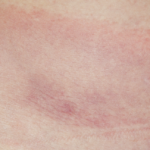She placed the sunglasses on her head and turned the page. “Okay. So after the tick bite, I didn’t notice much. I’d heard about Lyme disease—everyone’s heard about Lyme disease—but it wasn’t until the next spring—that would be eight months after the embedded tick bite—that I became sick. At first, I thought it was the divorce. I wasn’t sleeping well, and I’ve always been prone to headaches, but every day, my head throbbed. I gained weight. My glands felt swollen. At work, I was so tired I could hardly drag myself back to the office after lunch.”
“And the knee swelling?” I asked. “When did that first happen?
“Two months later. It blew up out of the blue. I took some sick time off, but that didn’t help.”
“And is that when you saw the orthopedist?”
“Right. He drew some blood.” She opened up the binder and handed me the lab results. I scanned through the normal chemistries and thyroid testing. An ELISA test, a screening test for Lyme disease, was negative. “He told me the X-ray looked normal. I didn’t need a surgery. Then he injected the knee.”
“And did that help?” I asked.
“It was great. I went back to work. But in retrospect, that was probably the worst thing he could have done. I’m sure you’re aware that injecting a Lyme-infected knee allows the infection free rein. When the swelling relapsed, I felt like someone exploded a bomb inside it. That’s when I began to see Dr. F., a Lyme-savvy doctor in Massachusetts.”
Doctor No. 2
“That would be, what, a year ago?” I asked.
“Yes. Here’s his original consult. I was a train wreck. I took a leave of absence from work. I felt light-headed all the time, woozy, I couldn’t concentrate.”
I read the consult. Dr. F. noted that although a second Lyme test was negative, Ms. Corinth demonstrated 32 out of 42 symptoms commonly associated with Lyme disease. This tally came from the circled YES/NO answers Ms. Corinth provided on the Lyme Disease Symptom Checklist. Included in the non-specific symptoms suggesting Lyme disease were: disturbed sleep, headaches, mood changes and twitching.
“Dr. F. told me the negative Lyme test represented a false negative, probably related to the inadequate initial treatment of the embedded tick the previous year. He emphasized that Lyme is a clinical diagnosis. Testing is notoriously iffy. No, I don’t think he used the word iffy, but you know what I mean, the symptoms, the big picture, that’s what he was looking at to make the diagnosis of Lyme disease. He was frustrated that the diagnosis had been delayed for so long, but he was optimistic that a full recovery was possible, even expected. Full recovery could still be achieved, that’s what he told me. So for three months, I took doxycycline in combination with the antibiotics, ciprofloxacin and azithromycin.”


